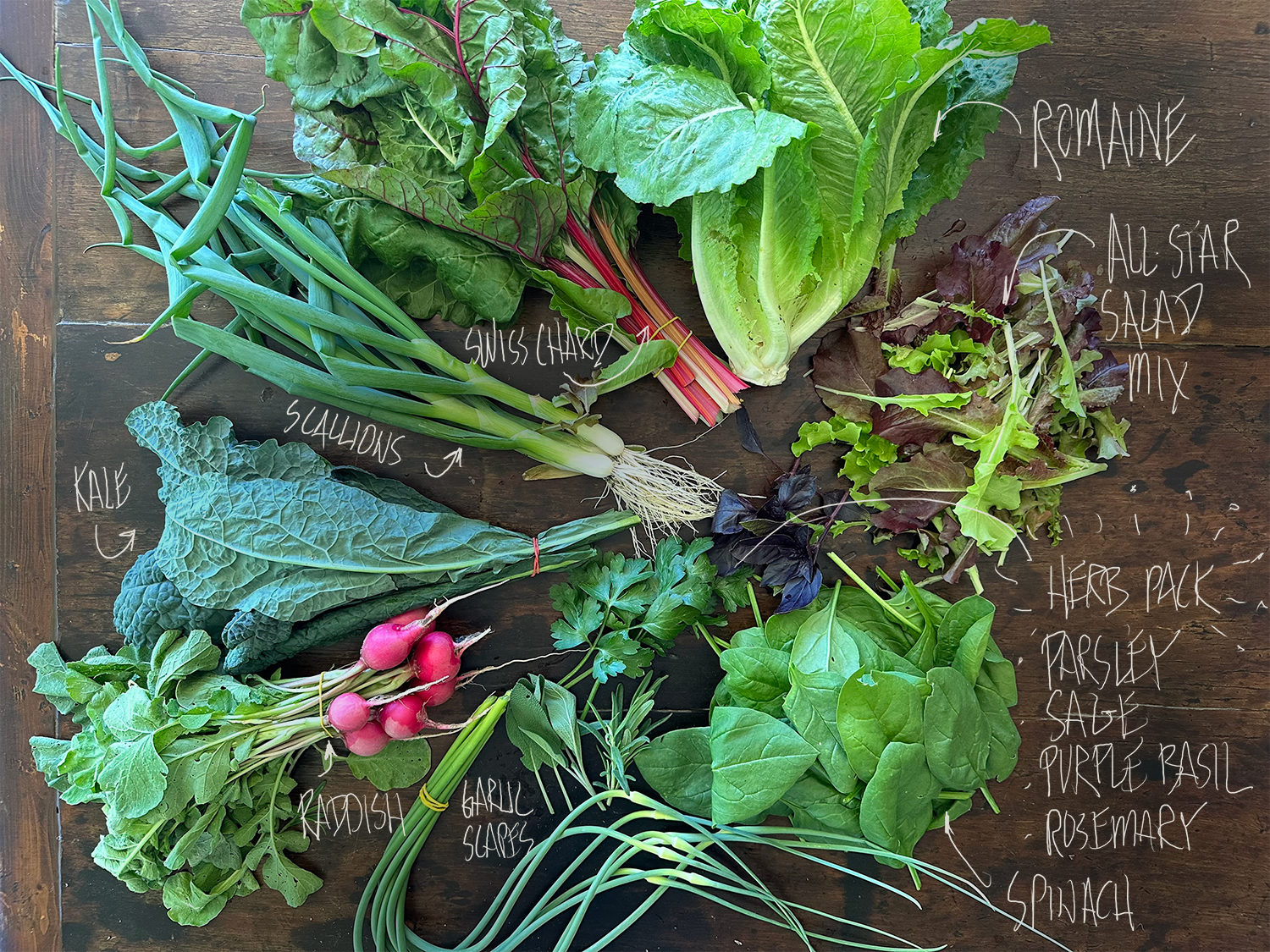2024 Spring | Week 9
A Salad Masterclass
Our crates are getting better and better. Our new spinach crop treats us to some of the most giant individual leaves we've ever seen! New this week are radishes and an herb pack (flat-leaf parsley, purple basil, sage, and rosemary). Hopefully, you got to try the garlic scapes last week; otherwise, you'll get another opportunity this week.
As we approach the end of our spring 2024 season, we're already planning for an exciting summer 10 week session. We have a diverse range of veggies in the pipeline, including 5 varieties of peppers and tomatoes, daikon radish, snap peas, green beans, broccoli, golden beets, more romaine, herb packs, fresh garlic, and french fingerling potatoes. We're eager to hear from our Farmtastik X community. Let us know if you're IN for the summer session ASAP.
What's in Your Crate this Week?
Click the plus sign next to each item for tips, tricks, and recipes!
-
Here’s what JOhnny’s says about this mix:A specially designed blend based on two years of trial research to make your salad mix stand out from the crowd. Selected varieties yield darker reds and greens even under low-light conditions. Ruffled edges and unique leaf shapes provide loft, interesting texture, good shelf life, and fancy appearance. Includes green oakleaf, red oakleaf, green romaine, red romaine, lollo rossa, and red leaf lettuces.
-
SCAPES 101 Raw garlic scapes are crunchy like green beans or asparagus, when cooked garlic scapes tend to take on a more muted and sweeter flavor similar to roasted garlic. Sauté your scapes with other fresh veggies to infuse everything with a subtle garlic flavor. Or, toss with oil, salt, and pepper and sauté or grill them - they’re great on their own or as a side. You can even cut them long to be used as a substitute for the green beans in a spicy stir-fry.
EAT NOW To prep, trim and discard the stringy tip of the scape and the bottom, woodier part of the stem. Cut crosswise, either minced or in large sections, depending on how you will use it.
OR LATER Store in a plastic bag in the fridge for 2-3 weeks or for a few days on the counter in a glass with cool water - bonus, it’s beautiful! Scapes can also be blanched, then stored in a plastic bag in the freezer for up to 1 mo.
RECIPES
yankeestreetfarm.com/blog/the-great-garlic-scape
-
KALE 101 - Wash leaves in lukewarm water. If your greens have thick stems, remove them by folding each leaf in half and slicing out the stem. Then, stack the leaves up and slice diagonally into 1” wide strips.
EAT NOW - Wrap unwashed chard or kale in a sealed plastic bag in the crisper drawer of the fridge. Best used very fresh, but may last for a week. To freeze, blanch washed greens, rinse in cold ice water, drain, and pack into airtight containers.
OR LATER - Swiss chard or kale can both be eaten raw or cooked. A longer cooking time is best as it brings out the sweetness in the greens. Extremely high in vitamin K and vitamin A, these nutrient-dense greens can help combat cancer and reduce blood pressure! Chard and kale can be used interchangeably with: collards, turnip greens, beet greens, broccoli raab, mustard greens, dandelion, and spinach.
-
ROMAINE 101 - Romaine lettuce belongs to the lettuce family, Asteraceae, and it is characterized by its elongated, sturdy leaves and crisp texture. It is a nutritious vegetable, rich in vitamins and minerals. Romaine lettuce is an excellent source of Vitamin A, Vitamin K, folate, and fiber.. If you’re looking for low carb options, try using the large leaves as a wrap with your favorite fillings. Or, whip together a crisp and delicious salad by mixing with other greens and your favorite fruits, nuts, or cheeses!
EAT NOW - Slice the head of your lettuce at the base with a knife and let the leaves fall open. Remove any damaged or leathery leaves, then tear remaining into bitesize pieces. Wash in a basin of cold water and spin dry.
OR LATER - Store unwashed lettuce in a plastic bag in the refrigerator. If you’ve already washed and dried it, place in a plastic bag with a dry paper towel in the bag as well and place in the vegetable crisper of your refrigerator.
RECIPES
-
SCALLIONS 101 - Did you know scallions, spring onions and green onions are all the same plant? Scallions are picked early, before a bulb forms, while spring onion and green onion are picked when more mature. Spring onions are sweeter and mellower than regular onions, but the greens are more intense in flavor than scallions. The bulbs can be red or white, depending on the variety, and while they can be used in much the same way as regular bulb onions, they are great grilled, roasted whole, or used like pearl onions. Scallions and spring onions are great raw in a marinade or salad dressing, or lightly cooked. You can even add it to your “freezer scrap bag” for a great veggie stock.
EAT NOW - Rinse onions in cold water and snip off the roots and anything that’s floppy or dried out. The minced greens are less pungent than the bulb and make a good substitute for chives. Use spring onion in almost any recipe calling for onions, raw or cooked, for a more subtle, less intense onion flavor. They are excellent in soups and stews. Try brushing onions with sesame oil, salt, and pepper and put them on the grill. You can also use any part of the onion for your freezer bag of vegetable stock ingredients!
OR LATER - Cut the top quarter off and stand (with root) in 1” of water. Cover loosely with ziplock and place in the fridge or keep on counter, refresh the water every three days. To freeze, chop and put in a freezer bag.
-
SWISS CHARD 101 - A member of the Beet family, Swiss chard can be eaten raw or cooked. A longer cooking time is best as it brings out the sweetness in the green. Extremely high in vitamin K and vitamin A, this nutrient-dense green can help combat cancer and reduce blood pressure! Chard can be used interchangeably with: collards, turnip greens, beet greens, broccoli raab, mustard greens, dandelion, spinach and kale.
EAT NOW - Wash leaves in lukewarm water. If your greens have thick stems, remove them by folding each leaf in half and slicing out the stem. Then, stack the leaves up and slice diagonally into 1” wide strips.
OR LATER - Wrap unwashed chard in a sealed plastic bag in the crisper drawer of the fridge. Best used very fresh, but may last for a week. To freeze, blanch washed greens, rinse in cold ice water, drain, and pack into airtight containers.
RECIPES
-
Radishes 101 Our radishes are delicious when raw, with a sprinkle of salt or butter. The spicy, raw flavor is a wonderful addition to slaws and salads, or you can sauté and roast radishes to bring out a more subtle earthly flavor. You can even try them grilled!
EAT NOW Scrub radishes well to remove dirt, then trim stem and rootlets. Slice, chop, or mince or leave them whole. Delicious raw or cooked.
OR LATER Remove leaves and store unwashed greens in loosely wrapped plastic bag in crisper. Store unwashed roots in plastic bag in fridge for up to 1 week.
RECIPES

